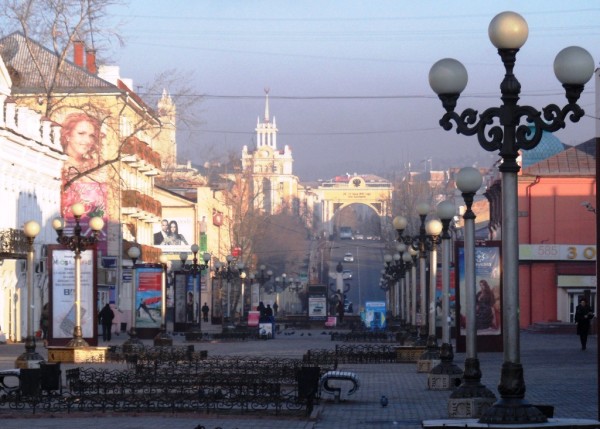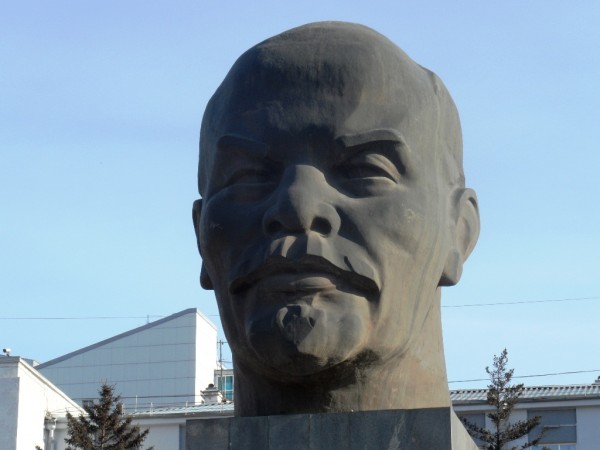
I stared out of the dusty train window at rows and rows of wooden houses. They seemed to go on for miles and, as the train slowed down, I assumed we must be nearing the train station – and arriving at my first destination after a 62 hour journey from Vladivostok. Instead, we just kept going, passing hundreds of these shack-like structures, their brightly painted shutters the only glimpse of life, loosely connected by wires swaying twenty feet in the air.
This was my introduction to Ulan Ude.
Um, where?
Ulan Ude is the capital of the Republic of Buryatia.
Um, that doesn’t really help.
The Republic of Buryatia, part of Russia since the 1920s, is located in south-central Siberia, stretching from the eastern shores of Lake Baikal, south to Russia’s border with Mongolia. Its history dates back to the Stone and Bronze Ages and its indigenous people, the Buryats, are of Mongolian origin – possibly even descended from Genghis Khan.
And in an area of Russia I expected to be somewhat dark and dreary, Buryatia reportedly enjoys more than 300 sunny days each year – including the two I was there.
Coming from the chaos and congestion of Vladivostok, Ulan Ude felt peaceful.
The streets in the city center were wide and clean, my hostel looked out onto the large open square surrounding the world’s largest Lenin head and not too far away I found Ulan Ude’s version of Moscow’s Arbat Street – a pedestrian-only zone covering several blocks.

I spent my first afternoon in the city exploring with Ian and Gordon, two fellow long-term travelers I met in my hostel. We took some obligatory pictures of the Lenin head, strolled along Arbat, grabbed lunch at an Italian restaurant, and then hopped into a marshrutka to venture 6 kilometers outside of town to the open-air Ethnographic Museum. There, we trudged through the snow to see a traditional wooden church, a series of Old Believers’ homesteads and, to our surprise, a small zoo featuring camels, yaks, wolves and even a couple brown bears (who looked horribly sad in their small cages).


The next day, I ventured outside of town to the center of Buddhism in Russia.
My main motivation for stopping in Ulan Ude was to visit the Ivolginsky Datsan – a Buddhist monastery complex about 30 kilometers south of the city and the center of Buddhism in Russia. Ironically, it was founded during Stalin’s times and with his permission. I looked forward to it as something that most people would not expect to experience in Russia, much less Siberia.
Although it is possible to make the trip alone, I splurged and hired a guide – a charming young woman named Olga. I really wanted to make the most of the experience and I thought that having someone along to explain what I was seeing and what I should be doing would be beneficial.

When we reached the datsan, we followed custom and walked around the complex in a clockwise direction. The complex itself consisted of small houses where the lamas live, as well as several temples of varying sizes – to be honest, they didn’t look horribly impressive. Along the path encircling the complex we passed several different types of prayer wheels and drums, a tree with prayer flags, large white stupa and a wishing stone.
Of course, I had to make a wish.
I am sure the wishing stone has some sort of more official, Buddhist sounding name, but either Olga didn’t tell me or I don’t remember. Anyway, Olga instructed me to put my hand on the stone (which was at about shoulder height) and make a wish, then walk to a line on the ground a few meters away. At that point, I turned to face the stone, put my hand out in front of me, closed my eyes and walked back toward the stone. If I had touched the stone with my hand, my wish would come true. Unfortunately I missed by a few inches – I hope that doesn’t mean my wish is guaranteed to not come true!
Our last major stop was the main temple (no pictures allowed inside). We removed our hats and, again, walked clockwise around the temple. Olga whispered to me as I took in the rainbow of banners, drums, benches and rugs covering the interior of the temple, then led me to the far wall which was covered with gold Buddha statues in varying sizes and forms. As we departed from the temple, we walked backwards away from the wall of Buddhas so as not to turn our back to the gods.

While my introduction to Buddhism was over, my exposure to Buryatia was just beginning.
After an hour of walking outside at the datsan, Olga and I stopped at a nearby cafe for some hot tea. As we drank our tea and talked, I learned that Olga is not ethnically Russian, she is Buryat. She and her husband (who is Russian) are also Protestant, putting them in the minority in an area where Russian Orthodoxy, Tibetan Buddhism and Shamanism rule supreme. Olga speaks great English and loves meeting foreigners – she has spent a lot of time with American missionaries who come to Ulan Ude. And although she has never been further than Novosibirsk (a town in Russia several hundred kilometers away), she longs to travel internationally. Listening to her talk about her family, her background and her views on ethnicity and religion was educational and fascinating.
After returning to Ulan Ude, Olga and I parted ways and I had a few hours of daylight left. Hoping to learn more about the Buryat culture, I made my way to the small Historical Museum on Profsoyuznaya Street. The few English explanation cards didn’t tell me too much, but the displays were interesting nonetheless. They included Buddhas and icons rescued from Buryatia’s monasteries before they were destroyed during Soviet times, as well as a couple dozen Tibetan medical charts, whose anatomical distortions were both amusing and disturbing.
Finally, I ventured up to the highest point in Ulan Ude – also the location of the Rinpoche Bagsa datsan. Once again, I walked clockwise around the complex, this time taking a detour to visit several meditation points that offered great views of the surrounding hills and forests. I took a peek inside the main temple, but when I found people inside in the midst of prayers, I ducked back out again, feeling out of place and not wanting to disturb them.



By then, the sun was starting to fade behind the hills and it was time for me to head back to the hostel, pack my things and head to the train station to move on to Irkutsk.
A day and a half in Ulan Ude passed much too quickly, but it was better than nothing.
